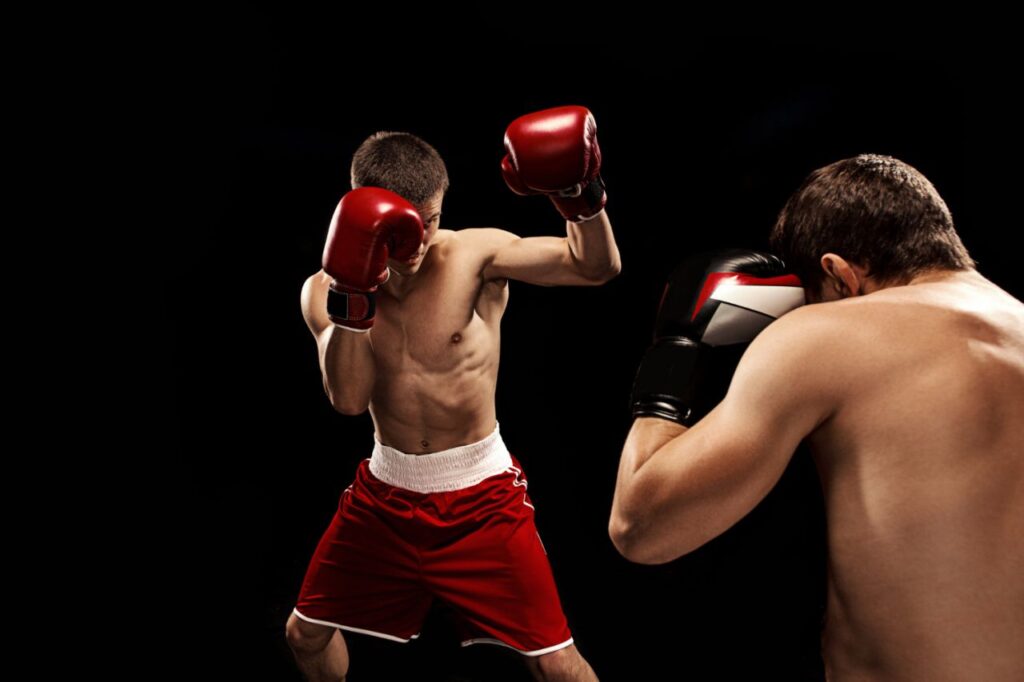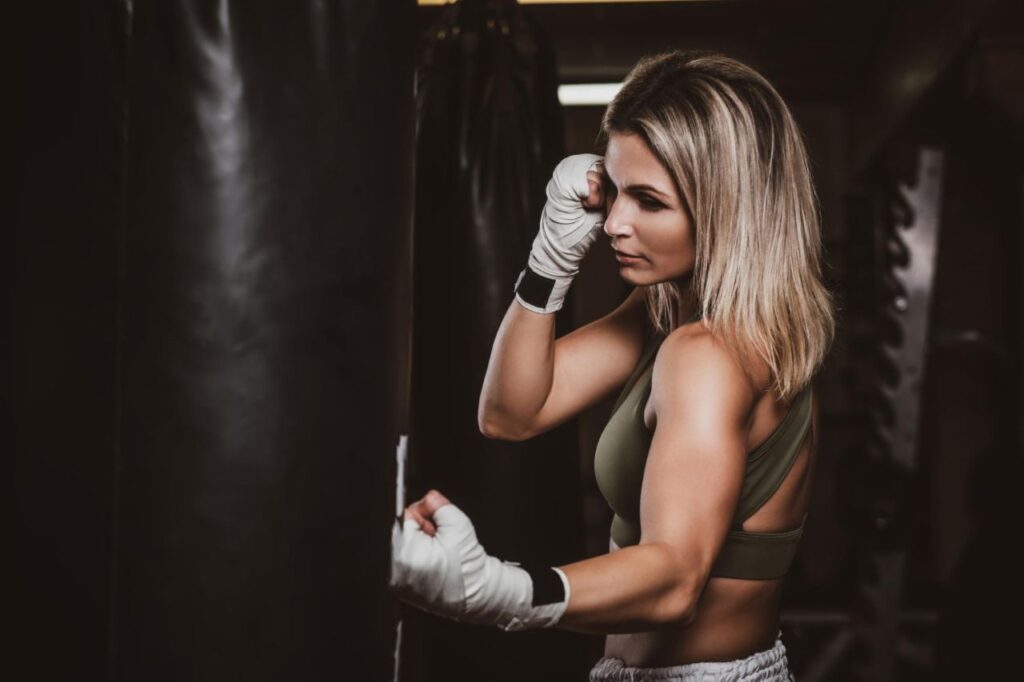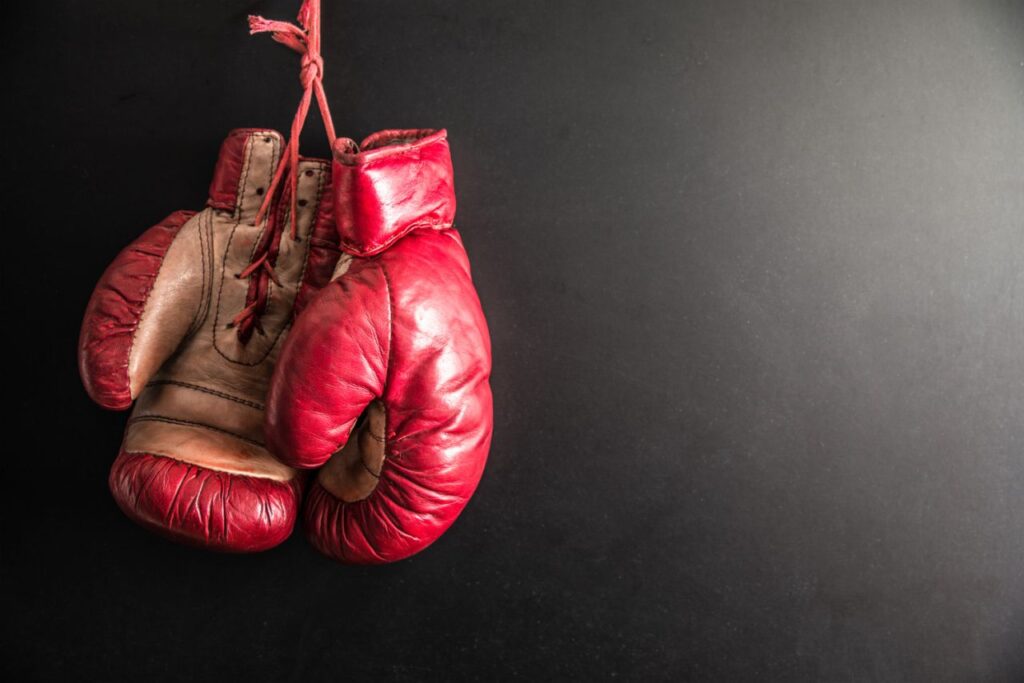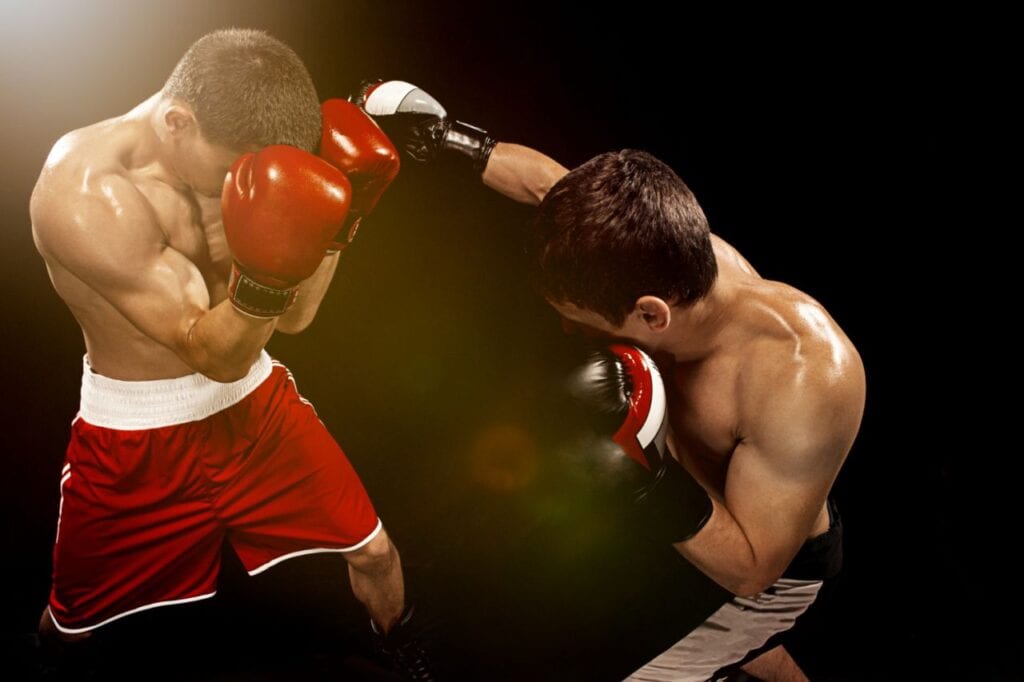There is no question that boxing is one of the best ways to develop your body. However, many people think that it is impossible to practice without a heavy bag or speed bag.
But, it is not true since you can do shadow boxing at home and many other exercises that do not require any equipment at all.
You may say that it is not the same as hitting a punching bag, but believe me, if you learn how to do this type of boxing workouts correctly and intensively, it is an excellent way to burn fat, develop your endurance and skills.
Shadowboxing is done by the professionals as well to improve their technique.
In order to practice boxing at home without any equipment, you need to find a space where you can safely move around. You can use this space to shadow box, work on your footwork and bag drills.
In addition, you can also do body weight exercises that mimic the moves used in boxing. By doing this, you'll be able to build strength and endurance while still having fun.
How To Start Shadow Boxing At Home?
Well, first, you will need a space where you can practice. Keep in mind that this type of workout is not about being in the same position and just punching in the air. You have to imitate it as if you were fighting with a real opponent.
Hence, you should practice the footwork. For that, you will need space.
It is not bad if you have a large mirror on the wall since it is easier to imagine a real opponent. Plus, you can check how you move, throw the punches, and practice the defense skills. By seeing your mistakes, you can correct yourself.
If you are a total beginner, you should learn boxing punches (jab, cross, hook, and uppercut) footwork movement, boxing stance, and defense techniques. In a nutshell, the boxing basics.
Start with single punches and practice them until you can throw them correctly. Then, you can start hitting easy combos such as jab cross, jab-jab, etc. If you are new to this type of workout, be patient and practice.
The more you practice, the more naturally you will throw those punches and combinations.
Meanwhile, spend time practicing footwork and defense techniques such as blocking, parrying, rolling, and slipping. Indeed, it would be better to start with footwork and not throw any punches, until you are good at your legs.
But since punching is the exciting part of this home training, just do it to be motivated.
Note: Jumping rope is a great boxing drill. All the benefits of cardio, coordination, agility, balance, and footwork in one exercise. Rhythm and timing are critical to jumping rope.
That is why these drills are so important for boxers.
The next step is to decide how many rounds you would like to do and the rounds’ length. That depends on your fitness level, and the best is if you use a timer. If you are a beginner, you can do 3-5 rounds that are 1-2 minutes long and have 1-2 minutes rest between.
Of course, as you get better, you should increase the number of rounds and the length up to 3 minutes and shorten the rest between the rounds.
Keep in mind the intensity is important, especially if you want to burn calories, but pay attention to perform the punches correctly, not let your hands down, footwork, etc. Also, do not start like mad and then just huff and puff.
A 20-Minute Boxing-Inspired Workout You Can Do At Home Without Gloves Or A Bag
There's no doubt this novel coronavirus pandemic has presented us with a lot of unprecedented situations (like all gyms being closed) — along with sky-high stress, anxiety and frustration.
One thing that can help? Staying active. Boxing in particular can be a great stress-reliever.
Try This At-Home Boxing Workout — No Equipment Required
There are three parts to this workout: jump rope cardio, ab exercises and boxing combos. "A boxer or fighter's workout is a combination of cardiovascular and strength training," Duquette says.
"Fighters have to be up on their feet moving around the ring for long durations of time, and jump rope is one of the best ways to build cardio endurance."
As for the ab exercises: A strong core protects you from body punches but also ensures that you can maximize the power of your punches, because proper punching is a total-body motion that heavily engages rotational power from your core.

Do: 30 seconds of each of the following moves, completing the full circuit four times
- Jump rope coast (light pace)
- Jump rope high knees (moderate pace)
- Crunches
- Leg lifts
- Boxing combo 1: jab, cross, jab, cross, sprawl jump
- Boxing combo 2: jab, cross, lead hook, rear hook, roll, roll
- Russian twists
- Shoulder taps
- Boxing combo 1: jab, cross, jab, cross, sprawl jump
- Boxing combo 2: jab, cross, lead hook, rear hook, roll, roll
Move 1: Jump Rope Coast
- Lightly skip in place over an imaginary jump rope.
Move 2: Jump Rope High Knees
- Skip over your imaginary rope at a faster pace, lifting one knee at a time up toward your chest as you hop.
Move 3: Crunches
- Lie on your back with your legs bent and feet flat on the floor close to your butt. Place both hands behind your head, elbows out.
- Using just your abdominal muscles, lift your head, shoulders and upper back off the floor without compressing your neck too far into your chest.
- Lower back down slowly and with control.
Move 4: Leg Lifts
- Lie on your back with your hands under your tailbone for support and legs extended straight out.
- Keeping your knees locked, lift your legs up until they're perpendicular to the floor.
- Using your abs, lower your legs back down again. Focus on not letting them hit the ground, instead hovering just above it.
Move 5: Boxing Combo 1
- Stand with your feet shoulder-width apart, your non-dominant foot a few feet in front of the other. If you're a righty, your left foot should be in front and your right foot should be behind the left and slightly to the side.
- Your lead hand (if you're a righty, your lead is your left) should sit at about eye level with your back arm tucked close to your body, nearly touching your ribs. Keep your rear arm along your cheekbone to protect your face.
- Jab: Punch straight out with your lead hand (same side as your front leg) and pull the arm back in.
- Cross: Punch straight out with your rear hand (same side as your rear leg), then pull the arm back in.
- Jab: Punch again with your lead hand.
- Cross: Punch again with your rear hand.
- Sprawl jump: Place your hands on the ground between your feet, hop them back into a high plank, then hop them back to your hands. Stand up and jump.
Move 6: Boxing Combo 2
- Stand with your feet shoulder-width apart, your non-dominant foot a few feet in front of the other. If you're a righty, your left foot should be in front and your right foot should be behind the left and slightly to the side.
- Your lead hand (if you're a righty, your lead is your left) should sit at about eye level with your back arm tucked close to your body, nearly touching your ribs. Keep your rear arm along your cheekbone to protect your face.
- Jab: Punch straight out with your lead hand (same side as your front leg), then pull the arm back in.
- Cross: Punch straight out with your rear hand (same side as your rear leg), then pull the arm back in.
- Lead hook: Throw your lead arm out slightly to the side of your body, then bend your elbow to a 90-degree angle as you swipe across your body. Shift your weight slightly to your lead leg.
- Rear hook: Throw your rear arm out slightly to the side of your body, then bend your elbow to a 90-degree angle as you swipe across your body. Shift slightly to the rear side, but keep your weight in your front leg.
- Roll: With your arms in a fighting stance (see step 2), bend both knees as you duck and lean to your rear leg side as if you were avoiding a punch. You'll also be leaning slightly back toward your rear leg.
- Roll: Bend your knees again to duck and lean toward your lead leg and slightly forward.
Move 7: Russian Twists
- Sit on the floor with your legs bent and feet off the floor. Hold your hands together at the center of your chest.
- Twist to the left and let your hands come with you, touching (or nearly touching) the ground on your left side.
- Come back through center, then rotate to your right side, bringing your hands along with you.
- Continue alternating side to side.
Move 8: Shoulder Taps
- Start in a high plank (the top of a push-up) with your hands under your shoulders and your body in a straight line from head to heels.
- Lift your right hand off the floor and tap your left shoulder.
- Lower your hand back down and repeat on the other side.
- Continue alternating right hand to left shoulder and left hand to right shoulder, making sure your hips stay square to the ground.
Other Ways To Practice Boxing Without Equipment?
Well, you can practice the traditional boxing exercises that are done by fighters.
Bodyweight exercises such as burpees, push-ups, squat, pull-up, chin-ups, sit-ups, walking lunges, etc.
And we should not forget running, jump roping, and plyometric exercises as well that we can do in a way of interval training.
Do not underestimate the efficiency of bodyweight training. It can help you a lot to develop your strength and endurance, things that are crucial for a home boxing workout.
Actually, these movements are a combination of strength training and cardio. Plus, we don’t need expensive workout equipment.
Finally, if you have somebody to train with, you can practice together.
Of course, not hitting each other, just imitate what is going on in the ring. If you have gloves and head and mouth protectors, you can spare, but it is not recommended without a coach’s instructions.
Pros And Cons Of Boxing: The Good, Bad & Ugly
What Are The Pros Of Boxing?
Discipline
The rich culture that surrounds this sport has emphasized the need for boxers to become self-disciplined both in the ring and in all aspects of their life. As an individual sport, boxing demands a high level of focus.
Each boxer is required to stay alert every moment of the fight, even a millisecond of absent-mindedness can result in a loss.
Participants in this sport develop the same culture in their daily tasks.
They eat the right foods to ensure a balanced diet, have a fixed schedule to follow, and also set goals that they have to accomplish each day.
Fitness
Professional boxers need to be in great shape in order to last the full 12 rounds if it comes to that.
That’s why endurance is key. Boxers are known to go long-distance running to help improve this, as well as the use of jump ropes for conditioning training.
But boxing is not just a sport, it has now evolved into a workout in order to help people to stay fit, especially older adults.
Fitness boxing is a risk-free adaptation of real boxing as there are no direct punches that may cause head trauma and other injuries.
The participants perform exercise routines and the movements used in real fights.
This has proved to have an array of health benefits, as the participants are required to constantly change their thinking, position, and body posture when exercising.
Boxing is a full-body exercise because one has to use muscles from both the upper and lower body. In the long-run, this results in a stronger upper body and frame, improved balance, and better posture.
It is also beneficial in having a better mood, better eye-hand coordination, and lengthens concentration period.

Agility
Boxing is a sport made of a mixture of both skill and use of strength, the ability of a boxer to make sudden and unpredictable movements is what separates a boxing pro and an amateur.
Making these random well-timed moves is what is called agility.
The training for agility is emphasized as it helps in better ability in stopping, starting, and changing of direction swiftly and fast. A boxer is also able to enhance his body coordination and balance.
Ladder drills are used to train for this and this full workout for the lower part of the body too.
Hand-eye coordination is also extremely important in boxing, some ways to improve this is the use of speed bags, double-end bags, and also training fast combinations with a partner who is wearing focus mitts.
Self-Defense
Training for boxing comprises a mixture of an array of attacking and defensive moves, one also has to check on his footwork movement and controlling the distance of the fight.
This gives you an edge in the event you are faced with a situation where you need to defend yourself. Boxers train on the best places to hit someone to deliver heavy blows that may lead to a knockout.
The more you train in boxing you learn how to add more power to your jabs as well improve balance.
A boxer will be more confident and their developed fighting mentality from training and fights in the ring; this comes in handy when they want to defend themselves. They are also better at taking punches, and ducking them due to having quick reflexes.
What Are The Cons Of Boxing?
Injuries
Since boxing is a high-intensity sport, injuries in the sport are unavoidable. Injuries ranging from severe brain damage, black eyes, broken teeth, injuries to the fingers and hands as well as muscle injuries are common.
However, most boxing enthusiasts live under the saying “no pain, no gain”.
In the history of boxing, there have been reported deaths and some vicious career-ending injuries for the boxers. It is therefore important to exercise caution when sparring and also in the ring.
Wear the right protective gear to minimize the dangers brought about by boxing.
This photo below shows a common look that boxers have after intense fights. Boxing isn’t for the faint-hearted, we want to make our readers (you) aware of that if you are new this.
Make sure that you have suitable protective boxing headgear if you are a beginner.
Not As Versatile As Mixed Martial Arts
Boxing only emphasizes on the use of hands and the upper part of the body.
It is therefore not very effective in street fights and cases of self-defense.
Another reason is that most boxers are used to wearing gloves in sparring and professional fights, this can make it a challenge in case a bare-knuckle situation erupts.

Unlike Muay Thai, where the use of unorthodox boxing techniques and the use of knee and elbow strikes are applied to defeat the other opponent, whereas boxing sticks to the rules, that can be limiting outside of boxing.
Boxing is more effective when the two opponents are standing.
If the fight goes to the ground then boxing techniques aren’t going to help.
Whereas someone who trains in Mixed Martial Arts is more well-rounded compared to a boxer; this is because the techniques in MMA involve both standing and ground training tactics. Just look at Nate Diaz being able to submit McGregor with ease.
This was because once on the ground his expertise in Jiu-Jitsu were more useful for the fight.
Deaths And Serious Injuries
The worst recorded deaths in boxing history will send chills up your spine.
One such death is of Duk-Koo Kim, who died in the ring, his death was followed by the suicide of the referee officiating the match and Kim’s mother.
Other deaths include Becky Zerlentes who was the first woman to die while in the ring.
This just shows how dangerous the sport can be. Some of the boxers may die later after a fight due to ruptured veins causing internal bleeding
Boxers are also known to have a high risk in suffering brain damage resulting from exposure of hard blows on their heads.
Statistics and research have proved that boxing leads to head trauma which may lead to permanent brain damage and other injuries to the head.
Historical data states that about 90% of the boxers tend to suffer from brain damage during or after their career.
Costly Gym Memberships
A fully functioning gym with a dedicated trainer and partners to spar with are not cheap. The gym costs tend to dent your pockets and have to be included when formulating your budget. Some gym costs may be very exorbitant making it hard to consequently pay the fee over the months.
Is Boxing Useful For Self Defense?
Boxing has been regarded as one of the top-rated mechanisms for self-defense. Well-timed head movements, clear vision, anticipation, and counter punches create a well-rounded defensive system.
Below are 5 reasons as to why boxing is effective for self-defense:
- A boxer will generally be healthy from training and fights in the ring. This can come in handy if one is approached by bullies on the streets as you can take them out with ease as you have accumulated endurance in fights.
- Fight mentality – An untrained person is not acquainted with the various scenarios that are presented by every fight. A trained boxer will be in a position to quickly judge a combat situation and apply the right technique to exterminate their opponent.
- Punching power – Boxers are taught and trained in tactics to increase their punching power. This comes in handy in self-defense. There have been stories of boxers knocking out muggers with a single punch.
- Boxing is a sport for everyone – Unlike some sports and other defensive techniques which are better learned by a particular gender, boxing is a welcoming sport to everyone. The rise in the fame of fitness boxing has also helped the elderly in ensuring they get a full-body exercise.
- A boxer has more refined motor skills – Boxing helps in having better reflexes and improvement of the reaction time. This makes a boxer confident in fights and in defending themselves.
Conclusion
So, there you have it! Whether you’re looking to get into boxing for fitness or self-defense purposes, or you’re just curious about the sport, these tips should help get you started.
Remember to always use caution and consult with a doctor before starting any new workout routine, and be sure to warm up properly.
And most importantly, have fun! Boxing can be a great way to let off some steam and improve your overall fitness level – give it a try today.
- Find a gym. Boxing gyms aren't typically found in the yellow pages, but there are resources on the internet that can lead you in the right direction. ...
- Be sure the gym is within striking distance. ...
- Be open-minded. ...
- Choose your coach carefully. ...
- Do judge the gym by its cover.
So, can boxing be self-taught? Boxing can be self-taught but it's not the quickest and most effective way to become better at the sport because you aren't able to tap into the knowledge of a boxing coach who would be able to help you one to one.
Best Age to Start
Specialists in sports medicine believe that boxing classes are better to start from 9-10 years. Starting too early could result in putting the student off, as boxing is hard work and not always as fun as team sports, such as football or rugby.

